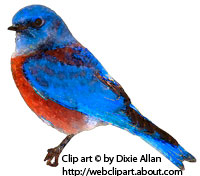Natural History
 Eastern bluebirds are very common in farm fields and other open, rural areas where woods are found nearby. In the summer, Eastern bluebirds eat insects. They are favored residents of farms because they eat many insects that damage crops. In the fall and winter, some Eastern bluebirds move to southeastern states while others remain as year-round residents.
Eastern bluebirds are very common in farm fields and other open, rural areas where woods are found nearby. In the summer, Eastern bluebirds eat insects. They are favored residents of farms because they eat many insects that damage crops. In the fall and winter, some Eastern bluebirds move to southeastern states while others remain as year-round residents.
To nest, male bluebirds find an attractive tree hollow or man-made nest box. When the male has chosen a nest site, he sings near it to try to entice a female to join him in setting up housekeeping. Eastern bluebirds lay, on average, 5 eggs in early spring that hatch about 12 days later. Once the young are on their own, the Eastern bluebird parents will often raise one more brood before fall comes.
Miraculous Bluebird Recovery
By the 1950's and 1960's, the numbers of Eastern bluebirds dropped dramatically. The reason for this was partly because less farm land, favored by bluebirds, was available. In addition, Eastern bluebirds compete with non-native House sparrows and European starlings for nesting locations. Other factors contributing to the decline of Eastern bluebirds included the use of pesticides like DDT. DDT directly affected Eastern bluebird’s food supply while also indirectly causing low reproductive success due to thin egg shells.
In the early 1970's, the plight of the Eastern bluebird was recognized throughout the eastern United States. Wildlife groups and bird clubs began to build and erect bluebird boxes. Both the bluebird nest boxes and the ban on the use of DDT have lead to a miraculous increase in the numbers of Eastern bluebirds. The bluebird and the bluebird nest boxes have become symbols of this success story in wildlife conservation.
While Eastern bluebirds have made a tremendous comeback, you can help further their success by building and installing nest boxes.

Nest Box Tips
- Erect boxes in large, open areas such as fields or farmland
- Do not place a perch on the box as bluebirds don’t need one and European starlings may benefit from one
- Do not paint box
- Place multiple boxes at least 100 yards apart
- Erect boxes by the 3rd week in February
- Place boxes 4-6 ft above ground and install a predator guard on the pole
- Place boxes at least 100 yards from buildings
- Remove nests from House sparrows or European starlings; it is legal to do so as both species are not native
- Remove nesting material after young leave so another brood can be raised
- Clean and repair box after last brood leaves, usually in September
Invite Wildlife to Your Backyard!
For more information, please contact:
Maryland Department of Natural Resources
Wildlife and Heritage Service
Tawes State Office Building, E-1
Annapolis MD 21401
410-260-8540
Toll-free in Maryland: 1-877-620-8DNR
[email protected]
Acknowledgements: